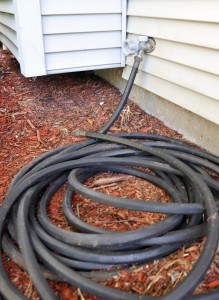
Billips said part of that evaluation will be an analysis of a “water in, water out” sewer rate structure where residents’ sewer bills are based on the volume of water consumed. (Photo by chief photographer Frederick Gore)
WESTFIELD – The Water Commission is awaiting delivery of a rate study to determine the Water Resource Department’s revenue needs which will provide the board with options to stabilize the department’s finances.
Dave Billips, Water Resource superintendent, said that the engineering and consulting firm of Tighe & Bond is currently collecting data on both the department’s water and sewer rates.
“Tighe & Bond is getting all of the information so we can determine where our rates should be,” Billips said.
Christopher Bone of Tighe & Bond said the firm will provide the Water Commission and the departments by late fall with “a model for water rates and a separate model for sewer rates”, as well as data the commission can use when “evaluating different rate structures.”
“Westfield is probably in the lower third of communities in the region,” Bone said.
Billips said part of that evaluation will be an analysis of a “water in, water out” sewer rate structure where residents’ sewer bills are based on the volume of water consumed.
Commercial water customers are currently assessed their sewer bill based upon the water-in, water out model. There is currently a mechanism in place for companies which use a substantial amount of water, so was cooling system which use evaporation technology, but return little water to the sewer system as a waste discharge.
Commission Chairman Ronald Cole said the data should show both the department’s projected costs and projected revenue.
“We need to be able to defend our position.” Cole said, that Westfield may be unique in that it has both ground water and surface water resources, each with a different cost factor.
Ground water, drawn from wells across the city requires a large amount of electricity to pull the water out of the ground and pump it to storage tanks that pressurize the distribution system, while the surface water sources, already at high elevations, requires energy to operate the city’s treatment plant system and chemicals used to treat surface water.
Billips also said that physical layout of the city’s water systems is a cost generator.
“We have a lot of watershed land that we have to maintain, all of the wells and Westfield is a large land mass so we have miles of pipes to maintain.”
Cole said that state law, which requires that the department budgets not exceed the previous year’s revenue, also creates instability budget because of the variability of demand is dependent on weather.
Cole said the rate study should consider the “elasticity of demand which effects usage and that (weather-related) usage decline impacts revenue” in constructing the rate models.
Bone said the data being collected covers at least five years of water use records which should mitigate the weather variable.
“We’re looking at five years to eliminate a one-season impact,” Bone said. “Our goal is to present a preliminary recommendation to you at the October meeting.”

